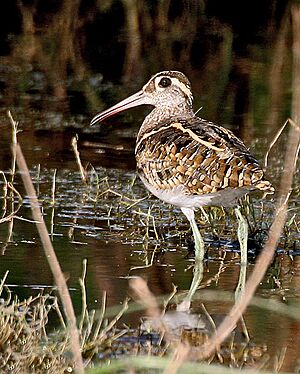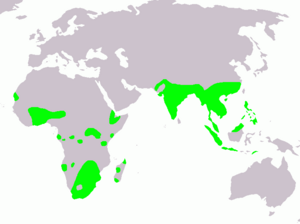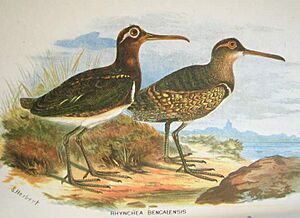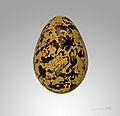Greater painted-snipe facts for kids
Quick facts for kids Greater painted-snipe |
|
|---|---|
 |
|
| Male on water | |
| Conservation status | |
| Scientific classification | |
| Genus: |
Rostratula
|
| Species: |
benghalensis
|
 |
|
| Distribution | |
| Synonyms | |
|
|
The greater painted-snipe (Rostratula benghalensis) is a cool bird found in wetlands. It's a type of wader, which means it loves to hang out near water. These birds live across Africa and southern Asia, often in swamps or by lakes and rivers.
Contents
Meet the Greater Painted-Snipe
The greater painted-snipe was first described by a famous scientist named Carl Linnaeus. There's a related bird in Australia, Rostratula australis, which used to be thought of as the same species. However, it's now known to be a separate, endangered species.
Where Do They Live?
Greater painted-snipes are found in many places around the world. You can spot them in mainland Africa, Madagascar, and even the Seychelles islands. They also live in India and across Southeast Asia.
In Africa, they are common in the Nile River Valley. You can also find them in parts of Sub-Saharan Africa that aren't rainforests. They usually avoid very dry desert areas. Even though they live in many places, they are not always easy to find.
What Do They Look Like?
Greater painted-snipes are medium-sized shorebirds. They have an interesting feature called sexual dimorphism. This means males and females look different!
Female painted-snipes are usually bigger and heavier. They also have brighter, bolder feathers. Their upper parts are a dark bronze-green. They have a reddish-brown area from their head down to their chest. A large white patch around their eye makes them stand out.
Males, on the other hand, are mostly grey and brown. Their upper parts are a light brown color. This helps them blend in very well with their surroundings, especially when they are sitting on their nests. It's like they have natural camouflage!
Home Sweet Wetland Home
These birds love wetland habitats. They especially like muddy spots that have lots of plants for cover. You can also find them at the edges of lakes and rivers, as long as there's vegetation nearby. Marshes and swamps are also favorite places for them to live.
How Do They Behave?
Greater painted-snipes are usually quiet birds. They don't make much noise unless it's breeding season. During this time, females might make soft "hooting" or "booming" sounds to attract males.
They often stay hidden near tall reeds along the edges of marshes, swamps, ponds, and streams. They are quite shy and like to stay close to plants. This way, they can quickly hide if something disturbs them. When they fly away, their legs often dangle, a bit like rails.
What Do They Eat?
Greater painted-snipes enjoy a varied diet. They mostly eat:
- Insects
- Small crustaceans (like tiny crabs)
- Molluscs (like snails)
- Seeds from plants
Reproduction and Life Cycle
Greater painted-snipes have a unique family life! Females are usually polyandrous. This means one female mates with more than one male. A female might mate with two males in a season, but sometimes even up to four!
The female is the one who starts the courtship. After mating, the male takes on the important job of incubating the eggs. He also takes care of the young chicks.
- Chicks: Baby painted-snipes are light brown with black stripes along their bodies.
- Young Birds: As they grow, young birds look a lot like the male. However, they don't have the broken dark band across their chest.
- Parental Care: Male painted-snipes are very caring dads. They are even known to carry their chicks to safety under their wings!
The nest is usually a small dip in soft ground. It's lined with plant material and hidden among grass or reeds near the water's edge. Sometimes, they build a small pad of plants or a nest of grass and weeds. The breeding season for these birds is typically between April and July.
Protecting the Greater Painted-Snipe
The greater painted-snipe is listed as "Least Concern" by the IUCN (International Union for Conservation of Nature). This is good news! It means their population is not decreasing too quickly, and they live in a very large area.
Gallery
-
Female in flight – Manjira Wildlife Sanctuary, Telangana, India
-
Closer view of a female – Kruger National Park, South Africa
-
Male with chicks - Hong Kong, China







